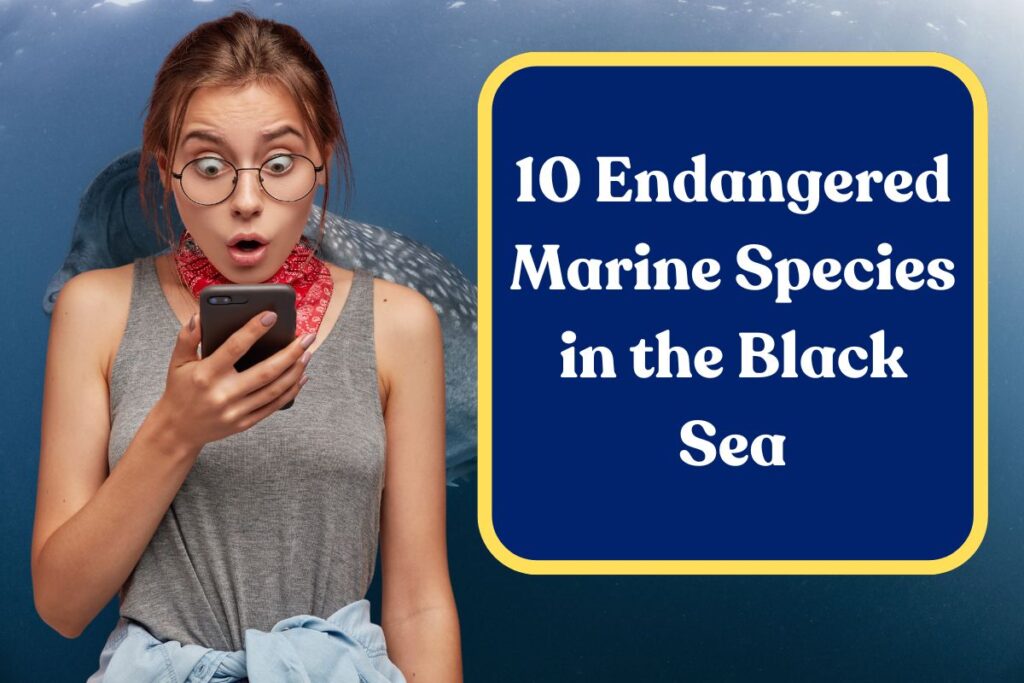Black Sea is home to thousands of marine species because of its unique layered structure which provides sufficient oxygen to the marine life. Furthermore, it also has a deeper anoxic layer where oxygen starts deplete which is a suitable habitat for other marine species in the Black Sea.

However, the increasing issues like environmental changes, water pollution, overfishing, and others have endangered some marine species in the Black Sea. Thus, in this article, we will explore the 10 most endangered species in the Black Sea and the factors which are responsible for their endangerment.
1. Azov Sea Kilka (Clupeonella Cultiventris)
Clupeonella cultriventris, often known as the Pontic sprat or Black Sea sprat, is a tiny fish that belongs to the Clupeidae family of herrings. It can be found in the Dnipro, Dnister, Danube (Ukraine), Southern Bug, Don, and Kuban rivers, as well as the Black Sea and Sea of Azov. Its scales are silver-grey and its skin is white-grey. It has a maximum lifespan of 5 years. It may be seen in massive shoals along seashores and in all-around coastal shallows.

It swiftly returns to the sea at a depth of 6 to 30 meters. Its flesh contains about 12% fat and is used as food. It is among the Sea of Azov’s most prevalent fish species. But, there are several factors because of which Azov Sea Kilka is in the list of endangered marine species. The factors are environmental changes, overfishing, and introduction of invasive species.

2. Black Sea Turbot (Psetta Maxima)
This species is a sea fish of the Scophthalmus genus. Its body is wide, rounded, oblate, and stout and its eyes are small and on the left side. Furthermore, Black Sea Turbot lacks scales and there are sharp small bone tubercles on its principal side (and occasionally on the blind side).

Their dominant side is dark brown, gray, and yellowish-olive which have dark spots. It typically occurs in great depths (up to 100 meters), clayey and sandy soils. It matures at five years of age, with a body length of 17 to 28 cm. However, because of their habitat degradation and overfishing issues, it is now in the endangered marine species.
3. Black Sea Bottlenose Dolphin (Tursiops Truncatus Ponticus)
The Black Sea bottlenose dolphins (Tursiops truncatus ponticus) are among the general bottlenose dolphin as it comes under their category. Recent studies indicate that they are different from the common bottlenose dolphin based on minor variations in cranial activity and genetic makeup. This species inhabits the Black Sea, and is less studied than the more prevalent Atlantic bottlenose dolphin.

But, the increasing tourist attractions including boat rides are drastically impacting the Black Sea Bottlenose Dolphins population. In addition to this, the bombs dropped during the Russia- Ukraine War in 2022 are also responsible for the declining population of the Bottlenose Dolphins.
4. Pontic Shad (Alosa Immaculata)
The Pontic shad (Alosa immaculata, formerly Alosa pontica) or Kerch shad or Black Sea shad is a clupeid fish belonging to genus Alosa which is found in the Sea of Azov and Black Sea basins. It is also present in the Marmara Sea of Turkey. Formerly the migrations extended far upriver, up to 900 km in Don and 1,600 in Danube, but at present, dams are limiting their migrations.

Though, the species formerly migrated as far into the upper reaches as the Mohács (Hungary) in the Danube but dam construction has restricted their migrations. Moreover, Pontic Shad is regionally extinct in Hungary. Overfishing and pollution could also be the cause for its decline.
5. Flathead Grey Mullet (Mugil Cephalus)
The Flathead Grey Mullet whose scientific name is Mugil Cephalus is a significant food fish in the family Mugilidae. The primary habitat of this fish are coastal temperate, tropical and subtropical oceans around the world.
It is usually measured up to the length of 30-75 cm (12 to 30 in). Although, the population of Flathead Grey Mullet is drastically impacted by the factors including their habitat degradation, pollution, aquaculture and overfishing.
6. Russian Sturgeon
The Russian sturgeon (Huso gueldenstaedtii), also referred to as the Danube sturgeon or diamond sturgeon, is a fish species belonging to family Acipenseridae. It inhabits Ukraine, Bulgaria, Turkmenistan, Azerbaijan, Turkey, Georgia, Russia, Iran, Romania, and Kazakhstan. Russian Surgeons also inhabit the Caspian Sea.
They are slow-growing and slow-reproducing, and so they are extremely susceptible to fishing. The primary factors due to which Russian Sturgeon fishes are endangered are poaching, habitat destruction, and overfishing. Thus, because of these major factors, population of Russian Sturgeon is declining swiftly.
7. European Eel (Anguilla anguilla)
The European eel scientifically referred as Anguilla anguilla is an eel species. Their life cycle was unknown for two millennia, and there has not yet been an observation of mating in the wild. Their five developmental stages were originally considered to be separate species. They are listed as being critically endangered because of hydroelectric dams, overfishing by fisheries on the coast for consumption by humans, and parasites.
8. Black Sea Porpoise (Phocoena Phocoena Relicta)
Black Sea harbour porpoise scientifically known as Phocoena phocoena relicta is a subspecies of the harbour porpoise widespread in the Aegean, Black, Marmara, and Azov Seas. The subspecies is the sole representative of the family within the fauna of these regions and is regarded as a narrow-range relict subspecies. The dolphin is commonly referred to as the “guinea pig” due to its up to four centimeters thick subcutaneous fat layer and noisily breathing, reminiscent of “grunting.”
But, the major factors which are responsible for declining population of the Black Sea Porpoise are noise pollution caused by human activities, habitat degradation and bycatch in fishing gear among others.
9. Spiny Dogfish (Squalus Acanthias)
The spiny dogfish scientifically known as Squalus acanthias, and other names are piked dogfish, mud shark, or spurdog is one of the most recognized species of the Squalidae (dogfish) family of sharks in the order Squaliformes. It occurs in shallow waters and more off-shore in most regions of the globe, particularly in temperate waters. Although, the population of Spiny Dogfish is drastically declining day by day due to the factors including bycatch, unregulated fisheries, slow reproduction, overfishing and many more.
10. Mediterranean Monk Seal
Tropical and subtropical waters are home to only a small number of pinniped species, such as the Mediterranean monk seal, one of the world’s rarest marine creatures. The number of mature Mediterranean Monk Seals remaining is currently between 440 and 540. The main threats to the Mediterranean monk seal include habitat degradation and displacement, pollution, intentional human killing, entanglement, and bycatch in fisheries.
The eastern Atlantic Ocean, Black Sea, and the Mediterranean Sea, which run along the northwest African coast, are home to Mediterranean monk seals. The Marine Mammal Protection Act lists the Mediterranean monk seal as depleted, and the Endangered Species Act lists it as endangered.
| Homepage | blacksea-commission.org |








